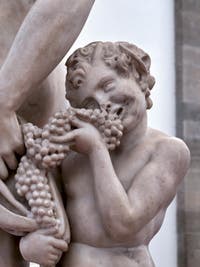Bargello Art Story | Location | Opening Hours Tickets | Authorizations
Art Story Donatello | Michelangelo | Cellini | Verrocchio | Giambologna | Cambio Ammannati | Earthenwares | Ivories | Palace
Michelangelo Bacchus | Brutus David Virgin Crucifix
Bacchus History Pictures 01 | 02
Michelangelo's Bacchus Sculpture at the Bargello Museum in Florence
Michelangelo “Bacchus”
Statue - Marble (207 cm) (1496-1497)Michelangelo, author of an ancient “fake”!
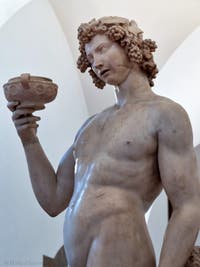
Michelangelo, Bacchus The statue of Bacchus was the starting point of Michelangelo’s prestigious artistic career in Rome. But this order was at first the result of deception...
Cardinal Riario invited Michelangelo to Rome after discovering that he was the author of a little sleeping Cupid, whose marble had been artificially aged and blackened to give the impression that it was an ancient work.
This small statue had, in fact, been presented to the Cardinal as a work dating from the time of Emperor Augustus by an intermediary who had charged him the tidy sum of 200 ducats... only to give the artist 30 ducats, telling him that he had not succeeded in selling it at a higher price.
The wealthy Cardinal did not appreciate the deception, but he wanted to receive this Florentine artist who had shown himself capable of competing with those of antiquity.
Michelangelo was summoned by Cardinal Riario to Rome
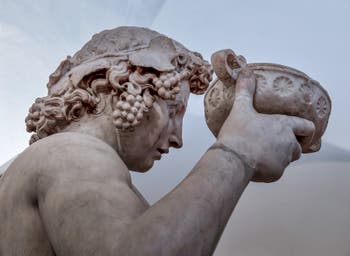
Michelangelo, Bacchus By showing him his rich collection of statues from the Greco-Roman period, Cardinal Riario decided to challenge Michelangelo, full of admiration for these works, by asking him if he felt capable of sculpting a statue as beautiful as these.
The 22-year-old artist knew how to be modest and replied that he was not sure he could produce such wonders but was ready to show what he was capable of.
Jacopo Galli, the Cardinal’s banker and treasurer, handled this order and transmitted Riario’s orders to Michelangelo.
The Statue Order
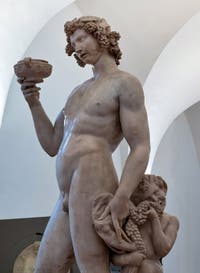
Michelangelo, Bacchus Cardinal Riario asked Michelangelo to sculpt him a life-size statue for which he would receive the sum of 150 ecus plus 10 ecus to buy the marble, a sum that he considered insufficient for such a block of marble.
But he was made to understand that there was as much marble as one wanted in Rome and at a low cost since the temples of the ancient gods and other buildings of antiquity were used as open-air quarries!
The marble block was carried to the garden of the banker Galli, who was hosting Michelangelo at home.
All that remained was work to create an original work capable of competing with the ancient artists who populated Riario’s collection.
Michelangelo chooses to sculpt a Bacchus

Michelangelo, Bacchus To support the comparison, Michelangelo decided to sculpt a Bacchus, a naked man in the classical Greek style, seen as a model of balance and harmony.
Among Greek sculptors, the secret of this balance lay in the “contrapposto”, in the opposition between the members.
If the right arm is raised with an object in hand, the left leg should be extended to support the whole body while the left arm and the slightly bent right leg are rested.
Michelangelo’s Bacchus, therefore, follows this classic contrapposto rule but with a few differences.
He rests on his left leg, holding a cup in his right hand to his half-open lips, his eyes foggy, his head tilted forward, his pelvis in a precarious balance because of his excessively bent leg.
But, because of this imbalance, and to prevent the statue from falling behind, it was necessary to leave a certain amount of marble behind Bacchus’s left leg as a safeguard.
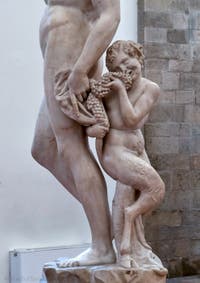
Michelangelo, Bacchus Michelangelo thus had the brilliant idea of sculpting a small gourmet fauna as a buttress instead of a banal truncated column that would have betrayed its function.
Cardinal Riario misses Michelangelo’s genius
Unfortunately for the young artist, the great collector would have said upon seeing his work:“I don’t like it. It will never be part of my collection. His lasciviousness bothers me; he is soft, has no balance, and lacks elegance. He is not divine!”
The Cardinal did not understand that by relaxing the classical pose of ancient statuary to give his character this natural and human beauty, Michelangelo had shown mastery and originality at the same time.
Bacchus abandoned in the Garden of Galli
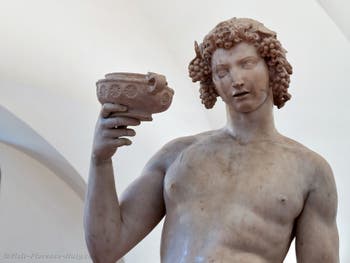
Michelangelo, Bacchus After this refusal, this Bacchus (Michelangelo’s first “Roman” statue) was abandoned in Monsieur Galli’s garden.
A painting by Martin Hermskerk painted in Rome around 1536 shows us a collection of antiquities in the Garden of Galli where we can see Michelangelo’s Bacchus... deprived of his right hand carrying the cup.
Perhaps broken deliberately to give the illusion that it is an antiquity that is one of the numerous Roman statues found during excavations.
Michelangelo’s Bacchus remained in Condivi’s garden until 1570.
It was bought by the Medici in 1572 for 240 ducats and left for Florence, where it was installed at the Uffizi from 1591 to 1873 before ending up at the Bargello Palace Museum, where you can still admire it.
Bacchus the Ubriacone, Bacchus the Pepperrot
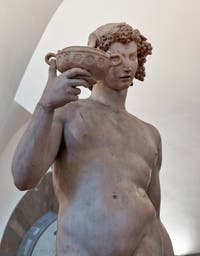
Michelangelo, Bacchus Michelangelo’s follower and friend, Ascanio Condivi, had perfectly seen the naturalness that gives rise to all the charm and originality of this statue:
“Bacchus has a head crowned with vine leaves, a cheerful face, the lascivious and oblique look of those who abuse the drink he invented.
He looks at the cup he holds in his right hand, while his left-hand reveals a tiger skin and a bunch of grapes that a mischievous little fauna is about to devour happily.”
Ascanio Condivi
Wild animals and animals were the usual companions of Bacchus; they symbolized the animal instincts released by drunkenness.
Michelangelo knew Ovid’s “The Metamorphoses”, which evokes Bacchus and his incredible procession:
“Follow you are followed by the Bacchantes, the satyrs, and the old man whose ferrule supports his tilting limbs and who has difficulty standing on the hunched back of his donkey.”
Ovid, The Metamorphoses
Bacchus is the god of celebration and pleasure
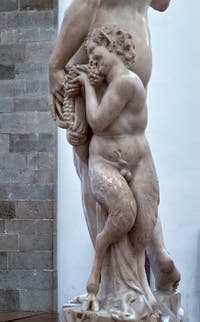
Michelangelo, Bacchus
“The maids and their mistresses were to suspend their work, cover their breasts with animal skin, untie the strips of their hair, wear a crown on their heads, and a thyrsus decorated with foliage in their hands.
Everywhere you go you hear the cries of young men, the voices of women, palm-banged tambourines, concave bronzes, and long pipe boxwood flutes.
Bacchus embodies inexhaustible youth; he is “the eternal child, the most beautiful being who attracts glances from the heights of the heavens.”
Ovid, The Metamorphoses IV
King Pentheus opposed the cult of Bacchus because he thought that wine and the excesses of Bacchanals were harmful to the men of his city:
Michelangelo, Bacchus “Children of the dragon, son of Mars, what delirium has struck your minds?
Do bronze shocked by bronze, the flute with the curved flag, and the spells of magic have so much power that courageous men allow themselves to be overcome by the screams of women, by the madness that wine arouses, by herds of obscene beings, and by tambourines with hollow sides? [...]
Thebes is about to be taken by a feeble child who has no taste for war, arms, and couriers and who only loves the myrrh with which he waters his hair, the crowns, the ornaments of softness, the purple, the bright, gold-studded clothing.”
Ovid, The Metamorphoses III
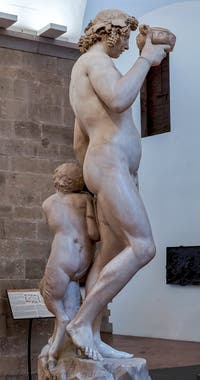
Michelangelo, Bacchus This aspect of Bacchus’s personality did not escape the genius of Michelangelo, as Vasari so aptly said:
“In this figure, we recognize that Michelangelo sought to restore a certain union of the two sexes, giving him the slender shape of a young man and the fleshy roundness of women’s forms, something admirable, and which showed that he was definitely superior in sculpture to all the modern masters who had worked up to that time.”
Gorgio Vasari “Lives of Artists” - 1550
Cardinal Riario did not know how to appreciate the sweetness and sensuality of this work, which was perfectly in keeping with the famous wine lover.
This is not the case with Italians, who smile while admiring Michelangelo’s Bacchus, whom they nicknamed “the Ubriacone” (the drunk).
Michelangelo's Bacchus Pictures
Bacchus History Pictures 01 | 02
Michelangelo Bacchus | Brutus David Virgin Crucifix
Art Story Donatello | Michelangelo | Cellini | Verrocchio | Giambologna | Cambio Ammannati | Earthenwares | Ivories | Palace
Bargello Art Story | Location | Opening Hours Tickets | Authorizations
Back to Top of Page


